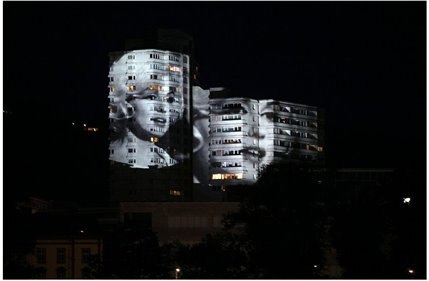The Big Picture (via Miraikan-Museum)
All exhibits whether directly or indirectly aim towards filling their visitors with new information, to influence them to act some way or change their perspective even if it is just for a moment. The Ars Electronica festival, in Linz, Austria, opened its doors to over 30,000 visitors for the 33rd time this last summer. Its goal was to directly focus on producing an experience that could make sense of the world’s fantastic and sickly states by way of emphasizing the interconnectedness of all spheres of life through scientific art that is creating a new culture for humans. In short, the organizers wanted to recreate something similar to the change in consciousness that resulted after NASA released the first photo of the entire Earth. The title of the festival, expressed this goal: to capture “The Big Picture”.
To achieve this, the festival hosted conferences and speakers from many different disciplinary backgrounds. Exhibitions, displays, concerts, performances, events and demonstrations brought art and technology together with biological, robotic, computational and other scientific works.
The Cloud in the Web - projections (via Rubra)
Different pieces fuse the line between our sense and technology like the “Sonic Suit” that uses skin receptors to detect the users vibro-tactile sonic vibrations and creates sound, blurring haptic and auditory boundaries.
Other exhibitions combine environmental information into interactive technology like John Steininger’s “Auditory Atmosphere Construction." This exhibit was comprised of a room where the sounds within it, interacted with an electromagnetic voice coil system, which caused the resonance of electro-acoustic tires that in turn, set off a pneumatic water fountain.
Annie Goh’s, “Electromagnetic Microcosm”, converts changing electromagnetic fields in its environment into visual and audible signals using ferrous dust on a clear table-top with and a speaker. The shortcomings of human sensory are evident as well as those of the scientific community, which still is inconclusive about some of the behaviors of electromagnetic fields.
A radio made in a Petri dish, used modified E coli bacteria to create the crystals needed to convert radio signals into DC signals as with a regular crystal radio. The “Bacteria Radio” was the work of Joe Davis, who says it demonstrates, among other concepts, the Vitruvian ideal, that the artist must always seek broader knowledge, especially in a world where knowledge is mostly privatized and use for-profit.
Lastly, a demonstration called Memopol-2 shows how capable and somewhat unsettling it can be to live in our digital age. Visitors lined up to have their identities exposed by social machine that maps out a person’s information field when an ID is inserted into it. By accessing international databases via the Internet, Memopol-2 constructs a custom display with all the users information on it.
Talks, presentations and performances titled, “Think With Your Ears”, “The History of Auditory Culture”, “Voice Box (that thing in your throat)” and many more, aimed to pull all events and exhibits into context. But in our current society of instant satisfaction, can a single display or conference convey this all-encompassing image? Of course not. Because even in that single photograph that first showed us the tiny world we live in, it could never show all of the minute and immense nuances, that in reality, make up “The Big Picture."
Cabe



